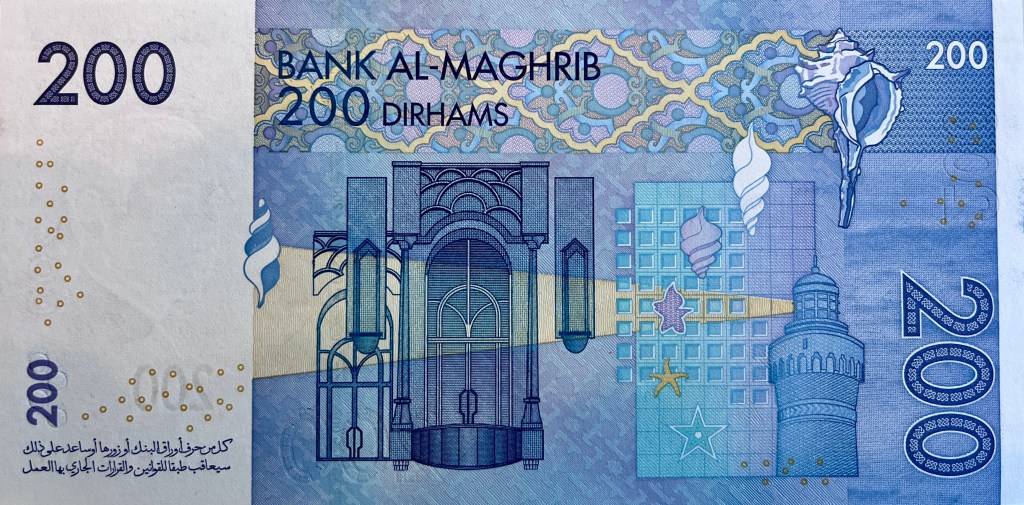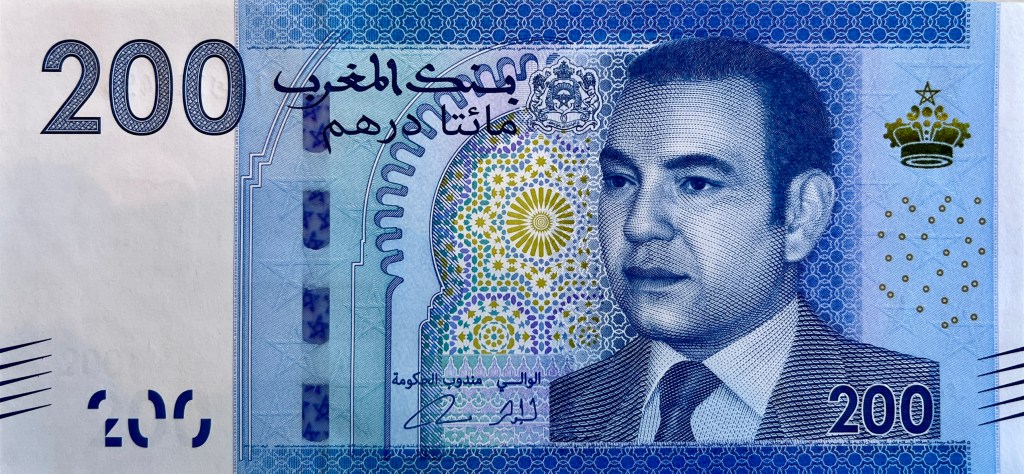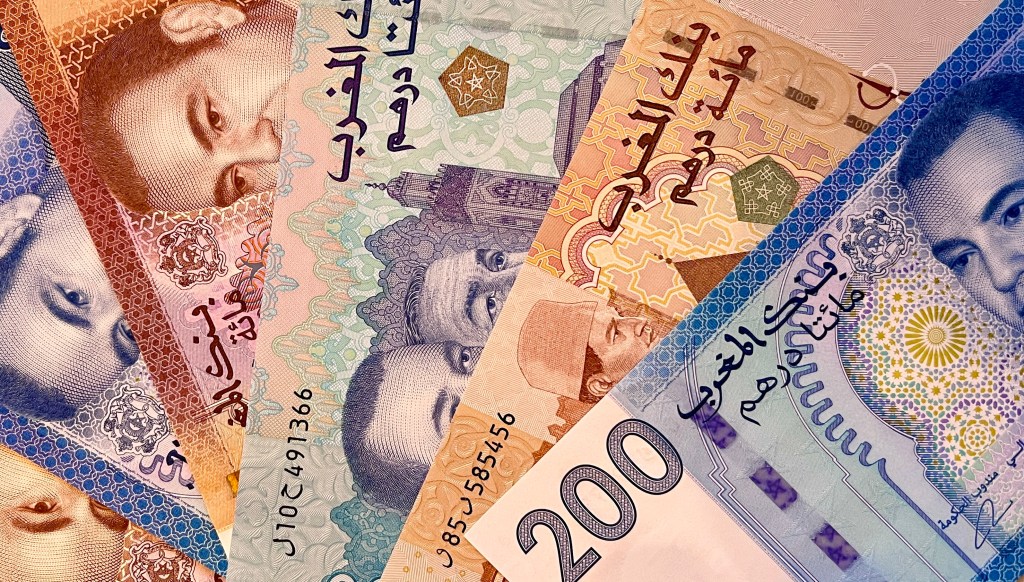The Dirham (MAD) is the national currency of Morocco. Its first appearance was in form of coins between the 8th – 10th centuries, followed by its second coming as coins and also banknotes as of the 20th century, more specifically 1960. That year marked Morocco’s independence following a period of nearly 50 years during which the country served as a protectorate of France (1912 – 1960). The currency during this period was the Moroccan Franc. Since independence in 1960, the Dirham has been holding strong as the nation’s monetary means. The Bank Al-Maghrib, Morocco’s Central Bank, issues Dirhams in the following denominations: 20, 50, 100 and 200. The notes are composed of paper material however the bank has also issued some commemorative notes that are either hybrid paper-polymer or full polymer notes (in the 25 and 20 Dirham denomination, respectively).
Interesting Fact: the first Dirhams to emerge in 1960 were printed over the existing Moroccan Francs and thus signaled the onset of a new monetary identify for the newly independent nation.

Obverse (2002 Series)
The 200 Dirham note from the 2002 series depicts the current monarch of Morocco, King Mohammed VI next to his father and former monarch, King Hassan II. To their right, the Hassan II Mosque (from Casablanca), is featured and just above it, the Moroccan Star. The right panel of the note consists of a watermark of the current king. The note’s dimensions are 158 x 78mm and the 200 denomination appears in three locations. The serial number is seen in black in the upper left corner and once again in the bottom right corner this time in red, combining alphanumerical characters. The inscription Bank Al-Maghrib is seen in Arabic just above the Hassan II Mosque. King Hassan II ruled Morocco from 1961 until his death in 1999, at which point his son (Mohammed VI), took over the crown. Today, the king is the country’s wealthiest person and also ranks not only as the richest monarch in Africa but also within the top five richest monarchs in the world. The dynasty the royal family is derived from dates from the 17th century, and has ruled Morocco ever since. The backdrop of the note depicts a decorative Moroccan motif on a mostly blue palette.
Numerous security features enrich the note’s visual an tactile nature from raised printing across various elements such as the kings’ portraits, to the mosque, and symbols indicating the value of note (for example, the four circles to the bottom right corner are designed for the visually impaired to distinguish its value). A windowed security thread running vertically is observed just to the right of the Moroccan Star bearing the micro print of “200” repeatedly. Light and color shifting properties are also integrated into the note in form of the shell near the watermark panel (which can be seen on the obverse and reverse of the note), and the 5-point star which turns from green to red depending on the angle the note is viewed from.

Reverse (2002 Series)
The reverse reflects continuity in the decorative motif serving as a canvas for the more prominent objects such as a window from the Theological School at Hassan II Mosque. Just to the right is a depiction of a sea shell that emanates from the 5-pointed Moroccan star. The star’s five points are symbolic of the five pillars of Islam. Another object featured on the reverse is the El Hank Lighthouse in Casablanca, perhaps symbolic of the country’s extensive coast that stretches over 2,500 kilometers, spanning parts of the Atlantic Ocean and the Mediterranean Sea. The note’s denomination appears in four locations and the Bank Al-Maghrib inscription is now shown in English.

Obverse (2012 Series)
The 2012 series 200 Dirham note shares in the blue hue of its predecessor although that’s where the similarities seem to cease. The note’s size is smaller at 151 x 70 mm, and its orientation appears reversed versus the 2002 series (with the watermark panel now appearing on the left). Another noticeable difference is that King Mohammed VI is the sole figure depicted as his father no longer shown. To the king’s left is a beautifully ornate moroccan door infusing brighter touches of yellow thus accentuating the overall appearance. The other denominations in the 2012 series also depict doors on their obverses, symbolic of Morocco’s openness as a nation and a people. The royal crown sits within the upper right corner with the Moroccan Star just to its north. Interestingly, there is no serial number depicted on the front of the note which means it must live on the back.
The note’s security elements comprise raised printing across various subjects as with the 2002 series note. The watermark showing the king along with the prominent security thread live on the left portion of the note. In the bottom left corner the 200 denomination becomes complete when the note is held up to the light while the five lines (also seen on the bottom right margin), are meant for visually impaired persons to indicate the note’s value. The royal crown shifts color depending on the angle at which it is viewed from, rounding out most of the security features on the note’s face.

Reverse (2012 Series)
The dominant scene on the reverse is that of a tranquil setting of Tanger-Med Port located in Tangiers, Morocco’s coastal city situated on its northern tip facing the Strait of Gibraltar. Next to the port is the Cap Spartel Lighthouse also in Tangiers set on a backdrop of moroccan rugs bearing a violet tone. The serial number appears in opposing corners of the bills in red and black ink. The note’s right side appears split into two panels, one comprising micro printing set on a blue background and next to it, is the watermark panel also depicting micro characters. The reverse of this note compared to its predecessor comes across more fragmented, as observed by the four delineated sections with different motifs, versus a more fluid theme depicted in the 2002 series.
My Two Cents
The 200 Dirham notes from the 2002 and 2012 series share some common characteristics led by their blue backgrounds and ornate features (reminiscent of patterns seen in Moroccan architecture, doors, rugs and other icons that define part of the country’s cultural identity). The latter series experienced a size change as the note shed some height and width but not at the expense of vibrancy. The color on the 2012 series has a popping effect and the integration of yellow allows its character to emerge more prominently. It’s interesting to observe the evolution of notes from one series to the next, although the more modern versions do not necessarily guarantee they are better (perhaps it’s a matter of preference). One can say I may be biased, as with the 2002 note I had the pleasure of acquiring in person on a trip to Morocco nearly 20 years ago and the memory will last a lifetime.
In more recent developments, the Bank Al-Maghrib released a 2024 Series 200 Dirham note that draws parallels to both the 2002 and 2012 series, fueling the continuum of Morocco’s largest denomination. Although I do not foresee a return to Morocco any time soon, the new note is available online and should make for a nice addition to the collection.

